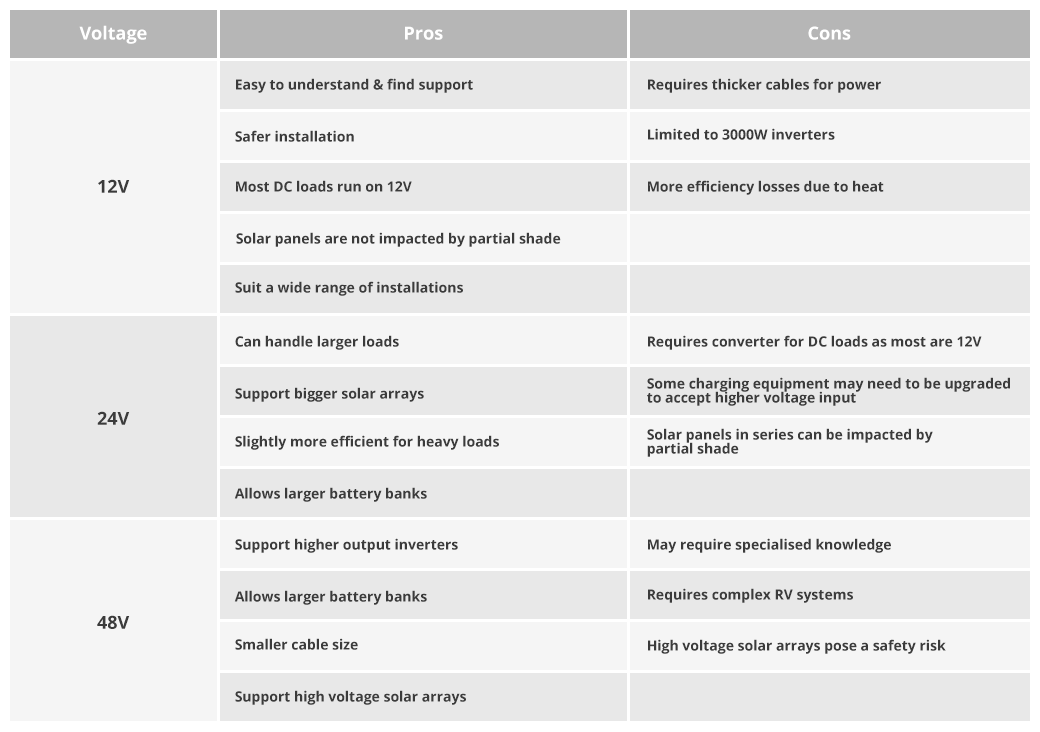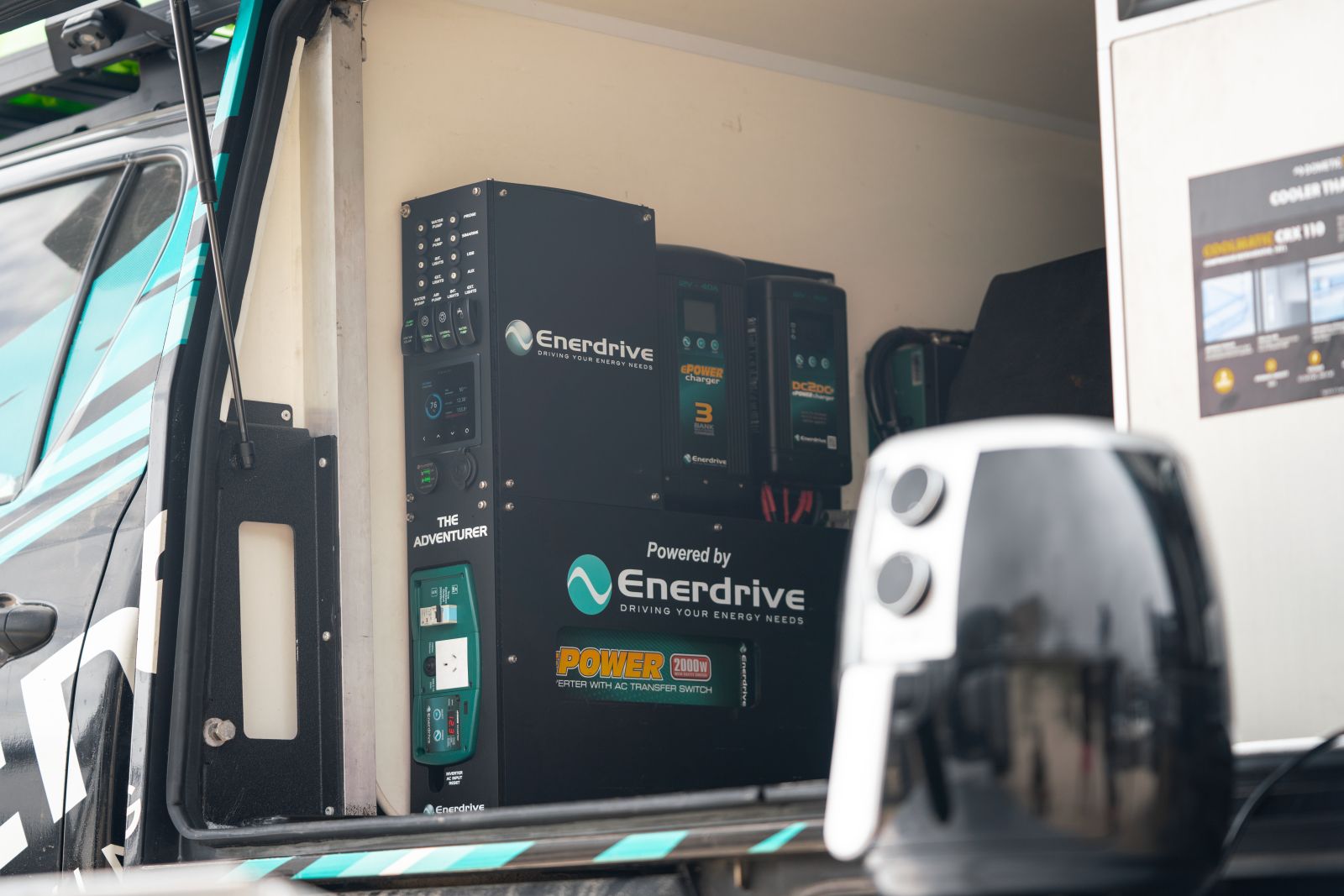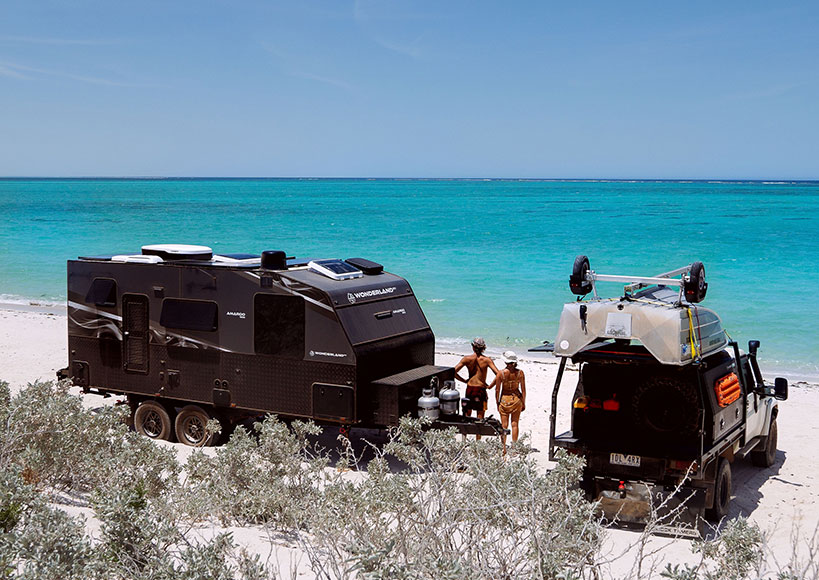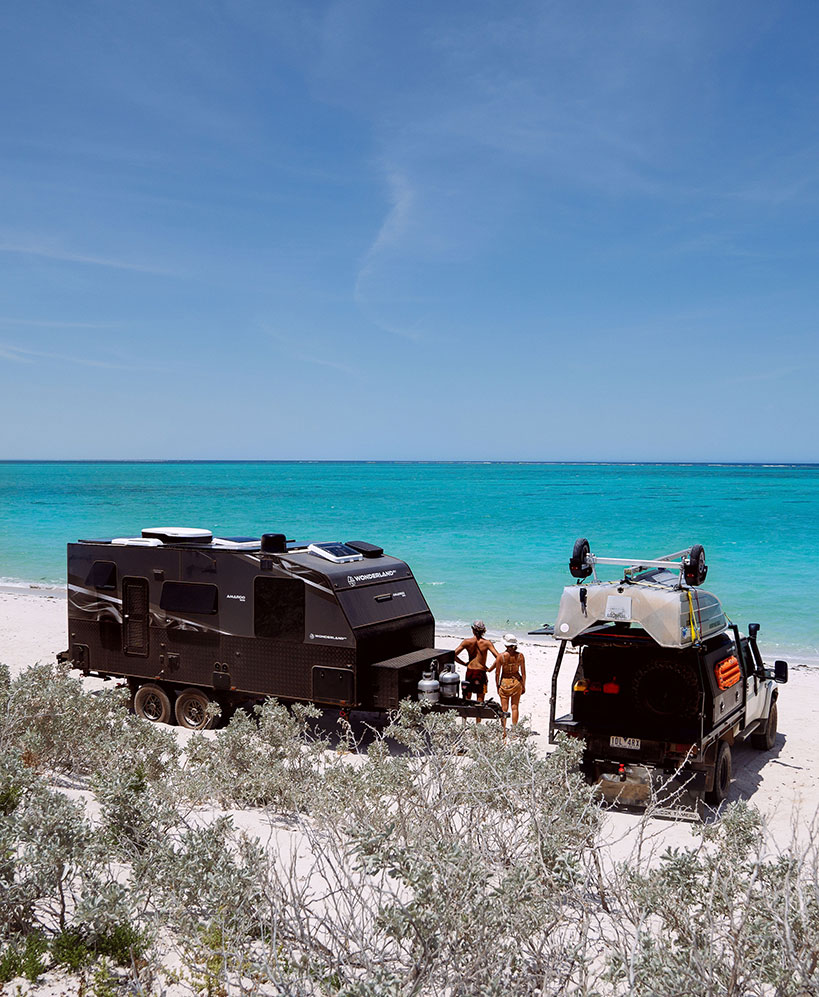Australia’s love affair with the great outdoors has taken a new turn in recent years, with more caravanners than ever embracing off-grid travel. From the red dirt roads of the outback to the secluded beaches of the coast, travellers are seeking the kind of freedom that only comes when you're not tethered to powered campsites. This trend is driving a surge in demand for reliable off-grid caravan power systems that can support extended stays in remote locations.
What Is an Off-Grid Caravan Power System?
An off-grid caravan power system is a self-contained energy setup that enables your caravan to operate independently from traditional power sources like powered campsites or mains electricity. These systems harness energy, typically through caravan solar power systems and store it in batteries for use when and where you need it.
At its core, an off-grid system includes:
-
Energy generation – often solar panels and DC charging via vehicle alternator
-
Energy storage – most commonly lithium caravan batteries or AGM deep-cycle batteries
-
Power distribution and management – using chargers, inverters, DC-DC converters, and monitoring systems for efficient caravan power management
These components work together to generate, store, and supply 12V and 240V electricity to run your essential appliances and devices while you're off the grid.
Core Components of an Off-Grid Caravan Power System
Designing a reliable off-grid system means finding the right components to suit your setup, travel style and energy needs. Let’s break down the essentials that make up a functional and efficient off-grid caravan power system.
Solar Panels
Your caravan solar power system starts with the solar panels. These are the primary method of energy generation for off-grid setups and arguably the most critical component of your system.
Caravan Battery Systems
If solar panels are the engine of an off-grid setup, caravan battery systems are the fuel tank. They store the energy you generate so it’s available when the sun isn’t shining—at night, during cloudy weather, or whenever your energy demand exceeds solar input. Selecting the right battery setup is critical for ensuring consistent, safe, and reliable power when you need it most.
There’s no one-size-fits-all battery system. Your ideal setup depends on your power usage, solar generation capacity, and how long you intend to stay off-grid. A basic system might include a single 100Ah battery, while a full-featured touring rig could require multiple 200Ah lithium batteries, especially when paired with a large inverter.
Battery Management and Monitoring
Regardless of battery type, proper caravan power management is essential. This includes:
-
Battery Management Systems (BMS) to prevent overcharging or deep discharge
-
Battery monitors or shunt-based systems to track energy usage and remaining capacity
-
Appropriate fusing and cabling for safety and efficiency
When integrated correctly, your caravan battery system becomes a reliable, low maintenance energy reservoir that supports your lifestyle, wherever the road takes you.
Inverters
A lot of the boards/systems will have an inverter. An inverter is going to convert 12VDC to 240VAC, to run household appliances with a 240V plug. These are rated by Wattage, so you will need to ensure the wattage is suitable to the wattage of the appliance. You will also need to consider an inverter has a very high draw on the batteries, the inverter's draw will need to match the discharge of the battery. Example: A 2000W inverter is rated to 166.6A (W ÷ V = A), so the continuous discharge of the battery will need to be at least 166.6A. General rule of thumb is 2000W matched with a 200Ah battery
Chargers
A DC-DC charger is an essential component in many off-grid caravan power systems, especially when using a dual battery setup. Its main role is to safely and efficiently charge your caravan battery system using power from your vehicle’s alternator while you're driving. Most DC-DC chargers also have an included MPPT (Maximum Power Point Tracking) which will allow you to run solar through the system safely.
An AC-DC charger is unlike the DC-DC charger, it plugs into 240V AC power to replenish the batteries. We highly recommend a system with an AC-DC charger, as you will always have a backup to charge if you are not driving and there is bad weather. Perfect if you are travelling to caravan parks or store your caravan and need to maintain charge in your batteries.
Wiring & Fuses: Safety, Sizing, and Connections
Reliable wiring is the backbone of any off-grid caravan power system. Poor cable selection or improper fusing can lead to voltage drop, overheating, or even fire especially in high current setups with lithium caravan batteries and inverters.
How the System Works Together
Understanding how each part of your off-grid caravan power system fits together is essential for designing, troubleshooting, or upgrading your setup. While each component plays a specific role, it’s the integration and flow between them that enables true off-grid capability.
Energy Flow: From Sun to Appliance
Here’s a simplified look at the journey energy takes in a caravan solar power system:
-
Solar Generation - Sunlight hits the solar panels, which generate DC power, typically at 18–22V depending on the panel configuration and conditions.
-
Charge Controller Regulation - The charge controller (usually MPPT) regulates the voltage and current from the panels to safely charge your caravan battery system. It adjusts charging based on battery chemistry (e.g. lithium vs AGM) and state of charge.
-
Battery Storage - The regulated power is stored in your 12V battery bank, which may consist of lithium caravan batteries for improved efficiency and depth of discharge.
-
Power Distribution
-
12V appliances (e.g. lights, fridge, water pump) draw directly from the battery bank
-
A DC-DC charger supplements charging from the vehicle’s alternator while driving
-
A monitoring system tracks battery health and energy usage
-
-
Inverter Conversion - When 240V AC power is needed, for appliances like kettles, laptops, or air cons, the inverter draws from the battery and converts it to household style electricity.
Understanding Nominal Voltage
When we talk about a “12V system,” we’re referring to the standard voltage of a caravan battery setup. While it’s called 12V, the actual voltage can range from about 10V to 14.6V, depending on things like battery charge level and type.
You’ll also hear people refer to 24V and 48V systems using the same naming style. It’s just a simple way to describe different setups.
Which Voltage is Right for You?
For most caravans, 12V is the best place to start. It’s simple, affordable, and suits the needs of most travellers. Only consider 24V or 48V if you have specific power demands that 12V can’t meet.
As a rough guide:
-
If your inverter needs are under 3000W, 12V or 24V will do the job.
-
48V is usually only needed for very large systems.
Why upgrade to 48V? Mainly for efficiency and weight savings. Higher voltage systems need less current, which means you can use thinner, lighter cables. Less current also means less heat, which improves overall system performance.
Appliances like coffee machines, air fryers, and induction cooktops are driving more demand for powerful 240V setups. A 48V system with a large solar array could one day power these appliances without a generator, but for now, this is still a niche setup. Most travellers are sticking with 12V systems.
Solar Voltage Basics
Just like battery systems, solar panels are also labeled by their “nominal” voltage. For example:
-
A 12V panel might actually produce 20V+ when not connected.
-
A 24V panel might show 40V+ open circuit voltage.
To charge a 48V battery system, you need a higher panel voltage—around 80V open circuit. You get this by connecting panels in series.
Pros of higher voltage:
-
More efficient
-
Lighter cabling
Cons of series wiring:
-
Shade on one panel affects the whole series string, reducing output
-
Parallel wiring avoids this issue, but needs thicker cables
Safety Considerations
High-voltage solar setups (like 48V systems with 80V solar arrays) can be dangerous if not handled properly. Always take care when working on or installing these systems.
Currently:
-
80% of mobile users stick with 12V solar
-
24V systems are used when more solar charging is needed
-
48V is still rare in caravans, but more common in home off-grid setups, where roof or ground shading is easier to manage
Pros and Cons of 12V, 24V & 48V Caravan Electricity

Sizing Your Off-Grid Power System
Getting your off-grid caravan power system right means you’ll stay self-sufficient and avoid flat batteries. Here’s how to size your system to suit Aussie off-grid adventures:
Step 1: Calculate Your Power Use (Energy Audit)
List all the appliances you’ll use, how much power they need (in watts), and how many hours you’ll use them each day. This tells you your daily power needs in watt-hours (Wh). To simplify this process feel free to use our inverter calculator.
Step 2: Size Your Battery Bank
To convert your daily use from Wh to Ah (amp-hours), use:
Watt-hours ÷ Voltage = Amp-hours
Example:
1,740 Wh ÷ 12V = 145 Ah/day
-
Lithium battery: Choose at least a 150Ah lithium battery (100% usable capacity).
-
AGM battery: You’ll need 300Ah (only ~50% usable).
Add 20–30% extra for cloudy days or unexpected use.
Step 3: Choose Your Solar Panels
Your solar setup needs to replace your daily usage.
Aussie rule of thumb: 1W solar = ~4Wh/day
1,740 Wh ÷ 4 = 435W solar needed (minimum)
To be safe, aim for 500–600W, especially if you’ll deal with:
-
Shade
-
Cloudy weather
-
Winter travel
Important: Make sure your solar controller and cables can handle the power. Larger setups may need:
-
Higher voltage arrays
-
Bigger or multiple controllers
Step 4: Pick the Right Inverter & Charge Controller
Inverter Size: Match it to your biggest load.
-
Coffee machine only? Get a 1,500W+ inverter
-
Air con + laptop? Go for a 2,500W+ inverter
Always use a pure sine wave inverter — it’s safer for electronics.
Charge Controller:
-
If your system is over 200W or uses lithium batteries, go for an MPPT controller.
-
MPPT controllers are more efficient and handle higher panel voltages.
Step 5: Plan for Future Upgrades
Building a long-term setup? Leave room to grow:
-
Use a bigger MPPT controller than you need now
-
Leave roof space for more panels
-
Install thicker cabling to handle more current
-
Choose modular lithium batteries that are easy to expand
Planning ahead = less hassle (and cost) down the road.
Top Brands
Enerdrive
Enerdrive offers one of the most versatile ranges of power boards and complete systems, catering to a wide variety of caravan and 4WD setups. Their solutions are popular for both DIY installations and professional builds, thanks to their quality and ease of use.
Victron Energy
Victron gear is featured in a variety of boards, including those by Solar4RVs, making them a strong choice for both caravans and ute canopy headboards. Victron’s Power Panel is a great alternative to Enerdrive’s DIY board, especially for setups that don’t require an inverter. Their A, A2, and B2 models all share core components— the A2 includes a Cerbo monitor, the A does not, and the B2 is a horizontal version of the A2 for flexible mounting options.
Projecta
Projecta systems are also a great match for caravans and ute canopies. Their pre-wired boards come with essentials like inverters, DC-DC chargers, monitors, and switches. The larger boards also include inverter chargers, allowing charging from mains power and featuring an externally mounted control panel.
BMPRO
BMPRO offers two compact models tailored to 4WD use. Each comes pre-wired with either a 25A or 40A DC-DC charger, along with switches, outlets, a fuse block, a shunt, and a monitor. These boards are ideal for travellers running only 12V appliances and charging from DC sources.
Renogy
Renogy’s Ranger board is a simple, reliable option for 4WD setups running 12V appliances. It includes pre-fused outlets and switches, and monitoring is done via Bluetooth. For customers wanting a fixed monitoring screen, the Renogy One Core monitor can be added to work with the Bluetooth shunt. Renogy's range keeps growing, as does their popularity in the Australian RV market - our team often recommend them as a reliable but affordable 12v power system option for Caravans / Camper Trailers / 4WD's.
Caravan Power Systems FAQs
-
1. Can I run air conditioning off-grid?
Yes, but you’ll need a powerful setup. Air conditioners use a lot of energy, so your system should include:
- A 2,000–3,000W pure sine wave inverter
- At least 300Ah of lithium batteries
- A large solar array (1000W+)
To make it work well:
Use an energy-efficient air con, run it during sunny hours, and keep usage short if you're on battery power only. -
2. How long will my batteries last?
It depends on the battery type and how you use them:
- Lithium batteries: Last 8–10+ years or 2,000–5,000+ cycles
- AGM batteries: Last 3–5 years or 300–1,000 cycles
To help them last longer:
- Don’t fully drain the batteries
- Use proper chargers
- Keep them cool and well-ventilated
- Use a monitor to track battery health
-
3. What’s the best battery type for Australian conditions?
Lithium (LiFePO₄) batteries are the best choice for off-grid caravanning in Australia. They’re:
- Lightweight and compact
- Better at handling heat
- More efficient at charging
- Great for remote travel and seasonal use
They cost more upfront but give you better performance and longer life than AGM or lead acid.
-
4. How do I upgrade my current system?
Start by checking what you have and what’s missing. A basic upgrade path looks like this:
- Energy audit – List your appliances and usage
- Add more solar – Roof or portable panels
- Upgrade batteries – Lithium gives more power and lasts longer
- Install an inverter – Choose one to match your appliances
- Add monitoring – Track power with a monitor or app
- Improve charging – Add a DC-DC charger or better solar controller
Tip: You don’t need to upgrade everything at once. Most systems are modular, so you can add to them over time as your needs grow.
-
5. Can I run 240V appliances on a 12V system?
Yes — but only with an inverter. You’ll need a pure sine wave inverter that can handle the power draw of the 240V appliance (e.g., microwave, TV, coffee machine).
At Caravan RV Camping, we offer a range of ready-made bundles to make choosing your caravan power system easy and stress-free.
In most cases, a well-sized 12V lithium battery system is more than capable of running high-demand appliances like air conditioners and coffee machines, thanks to their ability to handle high continuous discharge currents.
We often recommend sticking with 12V systems, paired with the right charging equipment. However, if your solar array grows too large for a standard controller and cabling, we may suggest a higher voltage solar setup to manage the current more efficiently.
Most customers opt for parallel-connected solar panels—either 12V or 24V—mounted on the roof. Series connections are less common due to shading risks and complexity.
Need help choosing the right setup? Our expert team is here to help you design a system that suits your travel needs perfectly.
-
DISCLAIMER* Please note, this advice is general in nature and we strongly recommend consulting the product manual and where relevant, a professional installer.


.jpg)
.jpg)







